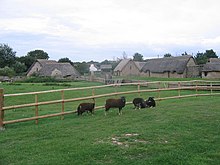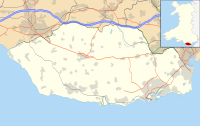Cosmeston Medieval Village
 |
|
|
Location within the Vale of Glamorgan
|
|
| Location | Penarth, Vale of Glamorgan, Wales |
|---|---|
| Coordinates | 51°24′48″N 3°11′02″W / 51.4134°N 3.1839°W |
| Type | Living history museum |
| Owner | Vale of Glamorgan Council |
| Website | Cosmeston Medieval Village |
Cosmeston Medieval Village is a "living history" medieval village near Lavernock in the Vale of Glamorgan not far from Penarth and Cardiff in south Wales. Based upon remains discovered during a 1980s archaeological dig in the grounds of Cosmeston Lakes Country Park, it is a re-creation of 14th century peasant life in Wales in the Late Middle Ages.
The reconstructed village regularly plays host to groups of reenactors, who camp in authentic tents around the outskirts of the village, and perform displays of historical combat for the public.
The original Cosmeston village grew around a fortified manor house constructed sometime around the 12th century by the De Costentin family, who were among the first Norman invaders of Wales in the early 12th century following William the Conqueror's invasion of neighbouring England in 1066. It is unlikely that the manor house at the site was a substantial building and there is documentary evidence that by 1437 the manor house had already fallen into total ruin. Its precise site has just been located. The village would have consisted of a number of small stone round houses, or crofts, with thatched roofs, as depicted in the current reconstruction, and the village population would have been between 50 and 100 people at most, including children.
The de Costentin family originated on the Cotentin peninsula in northern France. They were the first lords of the manor and they called the village Costentinstune, which over time became known as Cosmeston. They built the original manor house and, perhaps, a few dwellings or small farms, but for the next two centuries it appears that little further development occurred.
Around 1316 the manor passed into the hands of the de Caversham family, also of Norman descent.
...
Wikipedia

